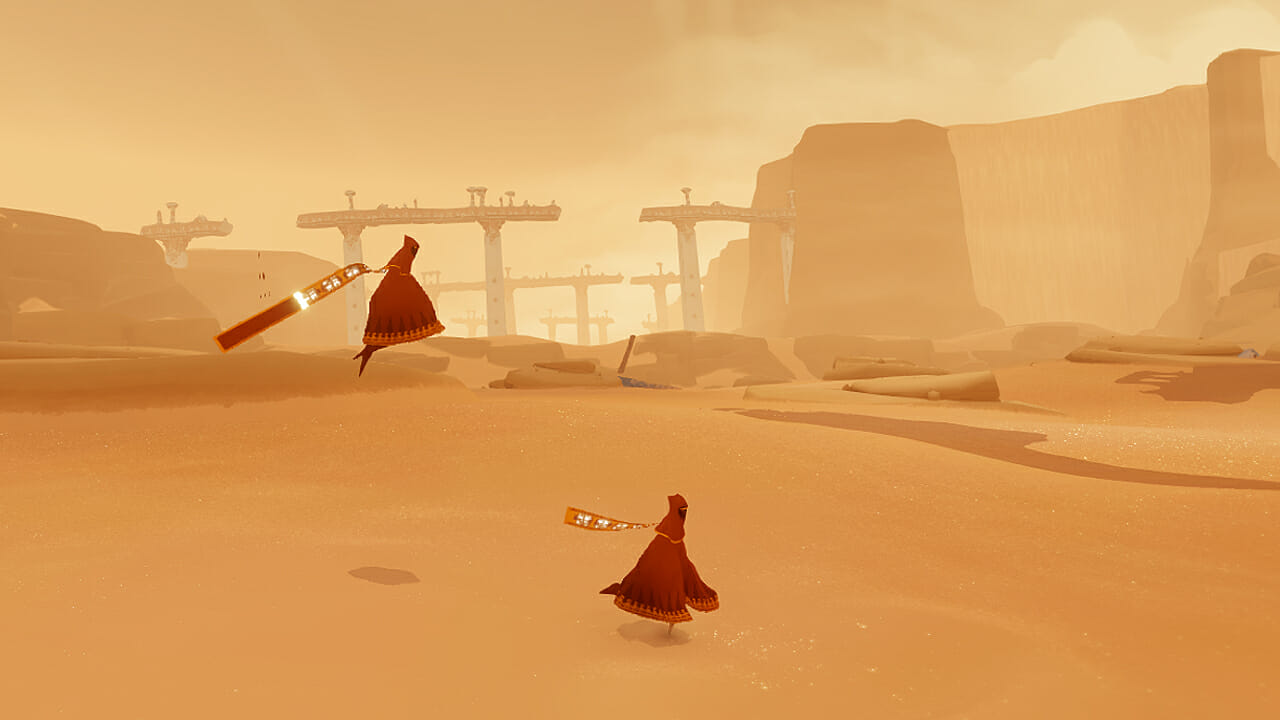Journey (PS3)

Thatgamecompany presents an abstract take on the hero’s journey.
I’ve never really gone on an adventure. Road trips don’t count, even with a stop at South of the Border. I did hang out in a desert once but I had a guide, a tour bus and a dozen other tourists at my back. The closest I’ve gotten to a quest is the time I went to five record stores in a day looking for a specific Fall album. My real life is supremely deprived of mythic glory.
I’m sure that’s a big part of why I play videogames. From Adventure to Mass Effect 3, games have pumped small doses of heroism into my sedentary life since I was five. Between that and the constant Joe Campbell parroting found in post Star Wars pop culture, I’ve lived through countless takes on the hero’s journey, all gliding together into one long uninterrupted fabric of high adventure. With a controller in my hand I am Link and I am Ramza and I am Fred McGriff in a fantasy world where the 1994 strike never happened (don’t tell me baseball isn’t an adventure). All different but all the same.
Journey strips that pattern down to its barest essentials. Thatgamecompany’s follow-up to 2009’s sublime Flower focuses like a laser on the most basic tenets of the hero’s journey, jettisoning the exposition and explicit character development expected from modern-day adventure games. Other than a wordless shout my red-robed hero is silent, largely without personality or history outside of what I create myself. His or her only goal is to reach the mountain that blazes just over the horizon, avoiding the typical videogame violence on what might be some sort of religious pilgrimage. My only goal is to enjoy the trip.
Journey paints in broad strokes, dealing in atmosphere and mystery and avoiding specifics. The ancient ruins of Journey’s desert are covered in indecipherable hieroglyphs, vast and trunkless legs of stone that I explore because I can and not because the game makes me. The darkness of its underground caverns shrouds me as I try to avoid the unknowable monsters that ominously fly above. I’m blasted by snow and powerful gusts as I make my last push up the frozen mountain face. Save points are sparse temples revived by my song, as angelic figures appear and animated hieroglyphs memorialize my adventures. There are no treasure chests, no friendly townspeople to chat with, just the peak looming ahead and the dangers of nature on the way.
I don’t just stroll through Journey, though. My hero wears a red scarf that grants the ability to fly. The length of the scarf defines how long I can stay aloft, and special icons hidden throughout the world increase its length. Little scraps of fabric can be found along the way, replenishing the scarf’s power and providing a boost that’s often needed to reach otherwise inaccessible perches. Eventually I free a flock of flying carpets from a desert castle, soaring among them with gleeful abandon.

When I first encounter the deadly sentinels that protect the later stages I take a direct hit and lose a significant stretch of my scarf. That hurts more than the loss of hit points ever could. Not only does it greatly reduce my flight time, it also cuts short what has developed into an integral extension of my hero. It’s like Samson losing his hair or Alex Trebek shaving his mustache.
-

-

-

-

-

-

-

-

-

-

-

-

-

-

-

-

-

-

-

-

-

-

-

-

-

-

-

-

-

-

-

-

-

-

-

-

-

-

-

-








































